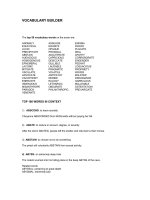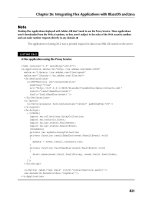Career builder mksaljf,abscmbưek,hnrfmcbsnv
Bạn đang xem bản rút gọn của tài liệu. Xem và tải ngay bản đầy đủ của tài liệu tại đây (127.75 KB, 4 trang )
1. Lecture
(CareerBuilder.com) -- Since the start of the recession in December 2007, the United
States has lost 8.4 million jobs. Yet, employers are finally feeling a renewed sense of
hiring optimism, according to a new survey from CareerBuilder and USA TODAY.
For the third consecutive quarter, more hiring managers and human resource
professionals are projecting they will increase headcount in the next three months while
fewer are expecting staff cuts. The nationwide survey of more than 2,700 professionals
was conducted by Harris Interactive.
Both the survey and hiring activity are signs of employers' confidence in the healing
economy and that they are ready to reincorporate growth strategies. The rise in online job
listings and resurgence in temporary hiring are strong leading indicators of a stabilizing
market and the creation of more permanent jobs down the road. On CareerBuilder.com,
for example, job listings in 2010 have increased both consecutively and year over year.
While the job market recovery will take some time as employers face new market
realities and weigh staffing needs, this is a positive sign for job seekers. In addition, it is
also welcome news to workers who have been strained by heavier workloads and longer
hours caused by their employers' staffing reductions.
In the first quarter of 2010, 23 percent of employers reported they increased their fulltime, permanent staff, up from 13 percent in the same period last year and up from 20
percent in the fourth quarter. Employers decreased headcount by 12, down from 26
percent year over year and down from 13 percent in the fourth quarter. Another 64
percent of employers reported no change in their number of full-time, permanent
employees while 1 percent was undecided.
Over the next three months, 23 percent of employers plan to add full-time, permanent
headcount while 8 percent plan to downsize staffs. The majority (64 percent) anticipate
no change in staffing while 6 percent are undecided.
Here are six trends hiring managers and human resource professionals said they foresee
regarding staffing in the second quarter of 2010:
1. Hiring contract workers -- Be open to job listings that indicate "contract" or
"freelance" work. Still cautious of hiring of permanent staff, 25 percent of employers
expect to employ contract workers or freelancers in the second quarter to help fill
productivity gaps. Thirteen percent said they are likely to hire these workers on a
permanent basis.
2. Offering internships -- No matter your age, consider applying for an internship for
the experience and exposure. Employers are upping their number of interns to costeffectively add resources in the interim. Nearly one-quarter of employers said that they
will be hiring interns at their location in the second quarter.
3. Hiring for social media -- Market your social media savvy. As social media rapidly
gains popularity among consumers and businesses, employers are taking notice and plan
to add jobs and responsibilities related to Web 2.0.
Nearly one-in-ten employers plan to hire a new employee in the second quarter to focus
on social media. An additional 13 percent plan to add social media management to a
current employee's responsibilities.
4. Adding bilingual staff -- In order to appeal to broader consumer segments in the
United States who may not speak English or speak it as a native language, employers are
looking diversify their personnel. One-third said they plan to hire bilingual candidates in
the second quarter of 2010. Half said that if they had two equally qualified candidates,
they would be more inclined to hire the bilingual candidate.
5. Replacing lower-performing employees -- Don't get lost in a false sense of security
and prove you're irreplaceable. Companies are re-evaluating their current staffs to prepare
for the upturn ahead. Twenty-eight percent of companies said they plan to replace lowerperforming employees with higher-performers in the second quarter.
6. Holding on to talent -- If you are that exceptional employee, your employer may
likely prove it. 32 percent of employers are concerned that some of their top employees
may leave their organizations in the next few months as market conditions improve.
To help retain workers, 14 percent are offering more flexible work arrangements, 14
percent are investing more in training, 10 percent are promising future raises or
promotions and 9 percent are offering more performance-based incentives such as trips
and bonuses. Another 5 percent are providing a higher title without the salary.
/>2. Sumary
Headcount will increase in the next three months while fewer are expecting staff
cuts.
Hiring contract workers
Holding on to talent
Offering internships
Six trends regarding
staffing
Replacing lowerperforming employees
Hiring for social media
Adding bilingual staff
3. Vocabulary
Optimism: (n) a feeling that good things will happen and that something will be
successful; the tendency to have this feeling
o Eg: We may now look forward with optimism.
Strategies (n) the skill of planning the movements of armies in a battle or war; an
example of doing this
o Eg: military strategy
indicators (n) a sign that shows you what something is like or how a situation is
changing
o eg: The economic indicators are better than expected.
Staffing (n) the number of people who work in an institution, a company, etc.
o Eg: the ability to maintain adequate staffing
Bilingual (n) a person who can speak two languages equally well
o Eg: Welsh/English bilinguals
Arrangements (n) a group of things that are organized or placed in a particular
order or position; the act of placing things in a particular order
o Eg: plans of the possible seating arrangements









